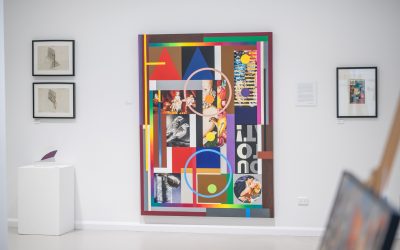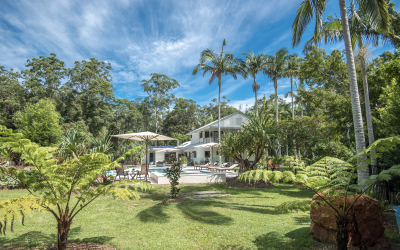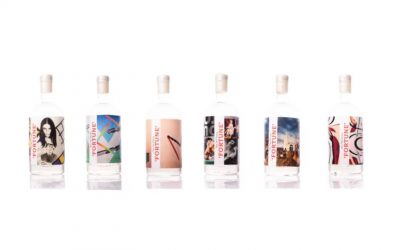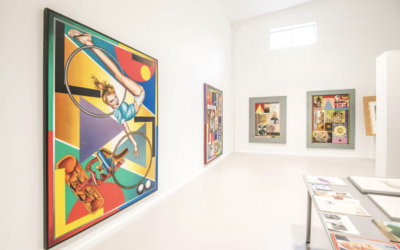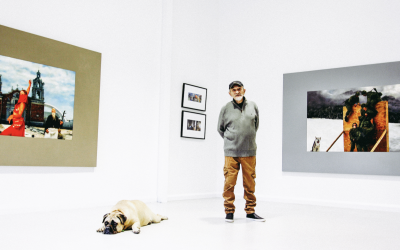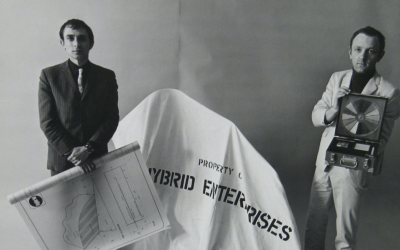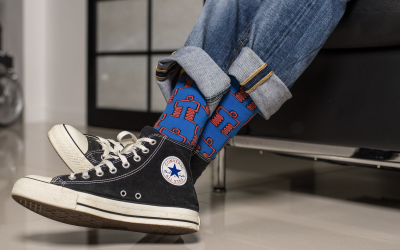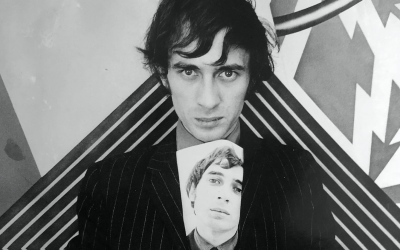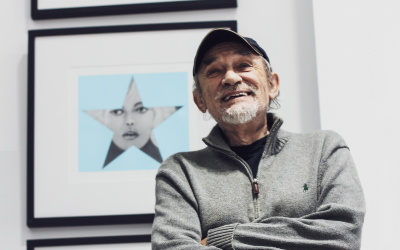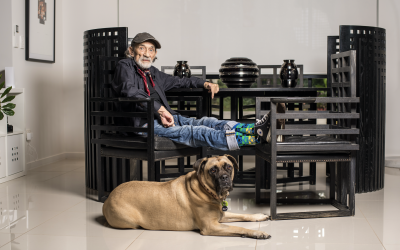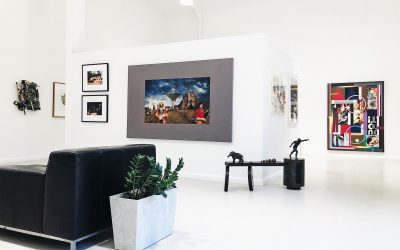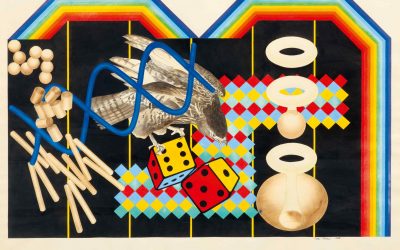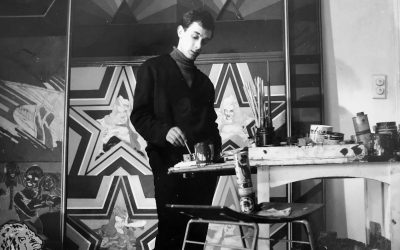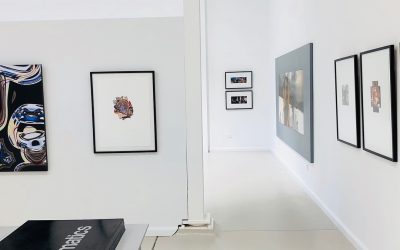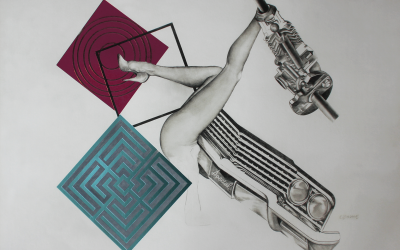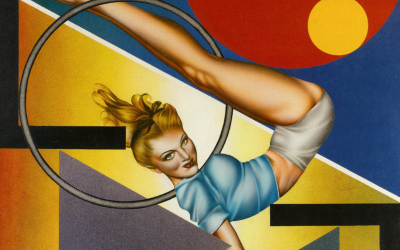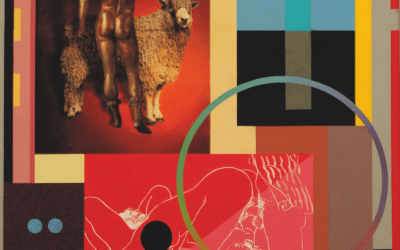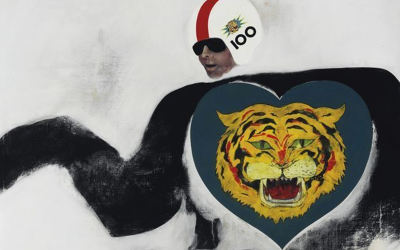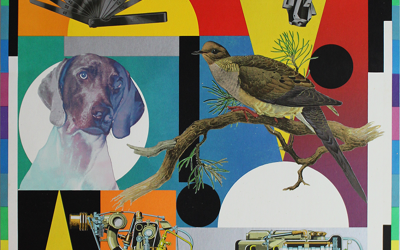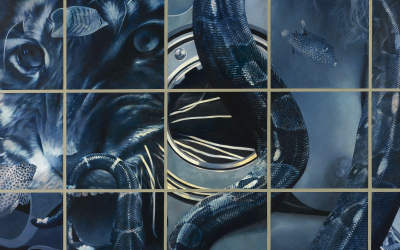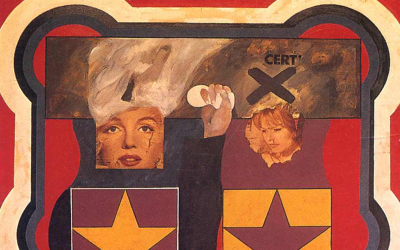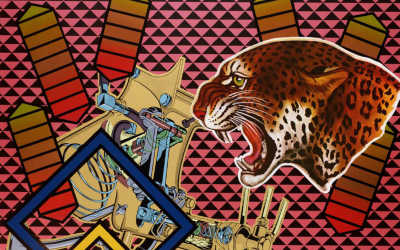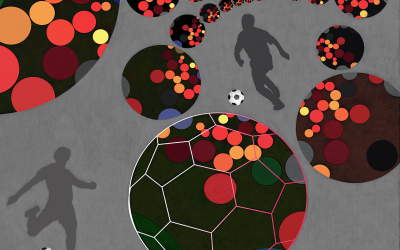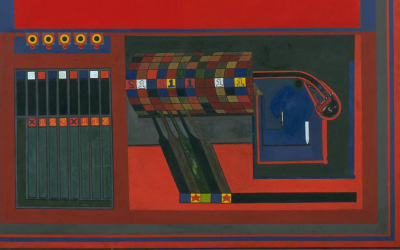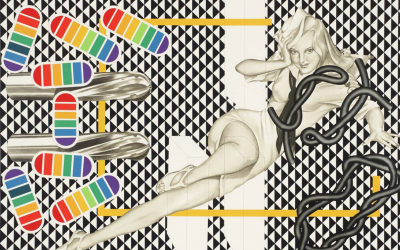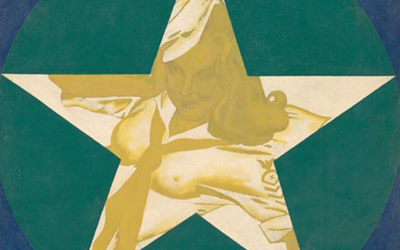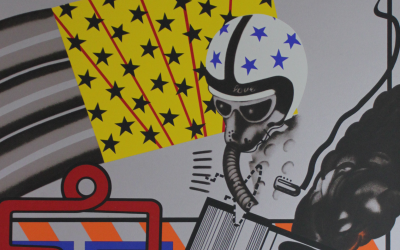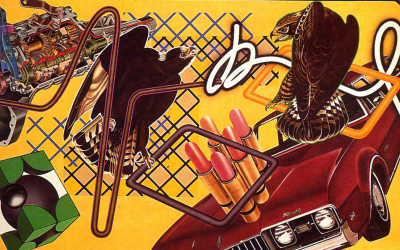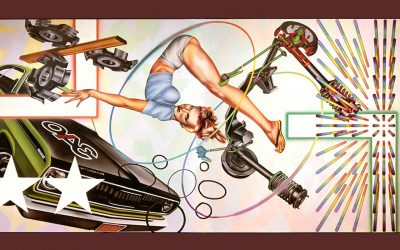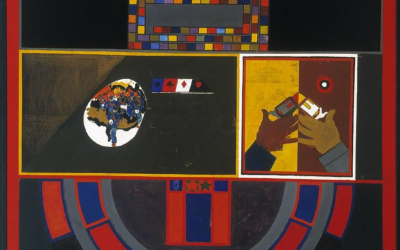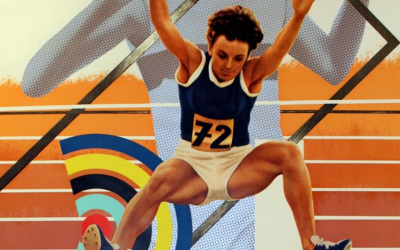Art + Australia on Peter Phillips
The tough guy of pop: An interview with Peter Phillips
Reclusiveness has always played a part in Peter Phillips’ life and work.
A pop artist with a cool detachment from the social trappings of that particular scene in London and New York in the 1960s; a Brit who left the country in his twenties to live in America, Spain, Switzerland, Costa Rica and now subtropical Australia and who has always held artistic ‘centres’ at a deliberate arm’s length; a creative practitioner who, despite the pop art label and critical alignment with artists ranging from Duchamp to Rauschenberg and Johns, has always held an immediately recognisable and highly original visual style, reflecting a mind that delights in the peripheries; Phillips has managed the singular trick of being seminal, without being all that social.
Not that his current home in Tinbeerwah, Queensland is particularly remote: Noosa is only a 15-minute drive away and Brisbane less than two hours. Phillips, just turned 80, lives here with his daughter, Zoe Phillips-Price, her husband Read Price, and their three-year-old daughter. Living in Australia as a result of a Distinguished Talent visa, Phillips works out of a home studio that houses many of his most famous pieces—including Art-O-Matic Riding High (1973-4) and the Star Card Table works (1962/2015), as well as paintings of the 1980s and 90s, such as Blue Study (1989), which beg obvious comparison with Joan Miro’s collagism.
Other pieces include Feeding (2007-12), with its undertones of social comment and condemnation of American foreign policy, and the coruscating Rape of Australia (2012-14). Phillips has, however, long insisted that his work makes no political statement and should not be interpreted as such. One might, however, interpret as a political gesture his appropriation of commercial and ‘everyday’ imagery for his signature 1960s paintings, in keeping with the well-documented view that pop art utilised the optical language of marketing, movies and pop culture to make a statement of dissent. It’s hard to argue this was ever Phillips’s intention: as he tells me, his use of commercial imagery came about simply because it was at hand, and it stood out visually and colourfully. It is, after all, the intention of advertisers to catch the eye; they certainly caught Phillips’, and his manipulation of adverts found in magazines and newspapers is neither a celebration nor denouncement of them. If anything, he is bringing an accessibility and sense of play to art—a counter to the dour traditionalism that Phillips and his contemporaries (such as Peter Blake, Derek Boshier and David Hockney) were force-fed at the Royal College of Art in London.
Marcel Duchamp once said, ‘I was interested in ideas—not merely in visual products.’ The exact opposite of that might apply to Phillips.
Phillips is currently working on a reimagining of his work Hybrid, originally created in 1966. This project saw Phillips, in partnership with Gerald Laing, interview the general public about their preferences in art, before working with a computer scientist at IBM to analyse the results. A large sculpture emerged from this collaborative project back then. Hybrid 2.0, in its early stages, promises to be quite a feat, producing algorithms through digital means, with its eventual presentation and medium yet to be decided.
This interview took place at the Tinbeerwah property with Zoe and Read also participating. Phillips, a reluctant interviewee for his entire career, remained a reserved presence, although still capable of a succinct turn of phrase.
‘It’s fun to paint,’ he says, ‘You get a new experience every minute as you’re slopping the paint on one way or another.’
Barnaby: I wanted to start by listing some of the cities you’ve lived in over the years, for you to comment on your fondest memories, the art community and overall impressions of each. Firstly, Zurich.
Peter: Is Zurich trendy? Zurichers think it’s trendy, but I don’t. I went there because of my wife and my dealer Bruno Bischofberger. It was a good place. The art scene was alright.
Zoe: You did a lot of partying in Zurich.
Barnaby: You were born in Birmingham [in 1939]. What did your parents do?
Peter: My father was a carpenter and a builder. My mother worked at Cadbury’s. Birmingham was fine when I was young. I went to school at Moseley Road Art School, got my diploma in art at Birmingham School of Art, then went to the Royal College of Art in London.
Read: You grew up in a planned community called Bournville, which was created by the Cadbury family, a Quaker family who set this community up on Quaker ideals.
Peter: Good guys, Quakers.
Read: When you were at Moseley Road Art School you won a scholarship that allowed you to backpack around Italy, so suddenly you were seeing all this art. In terms of the formative things that made you who you are, you’ve always spoken of Moseley Road, backpacking around Europe and going to Florence for the first time and seeing real art.
Peter: I filled my backpack with Murano glassware as presents for my mother and father. I had a backpack full of glass when I came home. It was a big step for a kid from Birmingham to be given money to go and look at real art. They had real art in Birmingham too, but they didn’t cultivate it very well. After all, all the Pre-Raphaelites were from there.
Barnaby: And London?
Peter: Well London’s a big place isn’t it? So what can you say about London? One has a good time in London. I was living in a house on Holland Road. All the people who lived around me were students and crooks and it was great. I could work. And everyone thought I was a nutcase.
Barnaby: And while living in New York on a Harkness Scholarship in 1964, you drove across America with Allen Jones.
Peter: I took him with me. I had the money and the car.
Barnaby: You stayed with Dennis Hopper on that trip. What did you get up to with him?
Peter: I didn’t get up to anything with Dennis Hopper, thank you very much! We met a lot of people, and we went to the places people went in those days. Crazy people. Certainly crazier in Los Angeles than they were in New York—and it was the real Los Angeles in those days. I think Harkness had other ideas in mind rather than me visiting crazy Dennis Hopper in Los Angeles.
Zoe: You always speak fondly of New York, because the artists were more open than they were in England.
Peter: Roy Lichtenstein was a good friend there. People were friendly in the arts scene, though it’s probably different now.
Barnaby: Another Harkness recipient was Brett Whiteley, perhaps a couple of years after you. But did you cross paths with him in London beforehand?
Peter: He was always everywhere. He lived round the corner from me in London, but he was Australian and we didn’t have that much in common, he was doing his own thing. He had a scholarship from over here and he certainly seemed well off—he had paper I couldn’t afford and an apartment I couldn’t afford. A typical Aussie with a lot of money. He gets pushed and pushed as if he’s the only artist Australia has ever had, but there are thousands who haven’t been pushed. And I don’t know why they push Whiteley, to be honest.
Barnaby: You were featured in Ken Russell’s famous documentary film Pop Goes The Easel (1962). What did that do for your career?
Peter: I don’t know, but it was a lot of fun. Ken Russell was on to pop art very early, he liked to be in front of everything, and he was in front of a lot of things in those days. You don’t turn down opportunities like that when you’re young and inexperienced. He was a nice guy to work with.
Barnaby: What aesthetics, artistic values, even morals, did you share with the likes of Hockney, Blake, Boshier and others?
Peter: We were just in the same place at the same time, when everybody was shouting at us for being irrelevant when we were at the Royal College, which was very conservative at the time.
Barnaby: You never had a problem with the pop art label?
Peter: Why should I? It didn’t bother me, it was what it was. Why make it out to be something else just because everybody thought pop art was not high art? For me it was high art, and much more visual than a lot of high art. I went my own way, which was mixing in with the people who were more real for me, people in books and magazines. David Hockney used to declare ‘I am not a pop artist’; he was shouting that at some point.
Barnaby: You two had a good relationship?
Peter: He’s the king of the castle. I’m the tough guy.
Barnaby: Politics has always been distasteful to you, hasn’t it?
Peter: I never believed in politics, still don’t. Let’s change the subject.
Zoe: He might not admit it, but I think there’s a lot of political commentary in his paintings, throughout his career, and especially in the paintings he made during the second war in Iraq. There is a lot of military imagery in that work.
Peter: I was born during the war as the bombs were dropping on Birmingham, which they did occasionally, blowing up houses where people lived. You don’t take it lightly, it goes into your body. I get upset even now when I think about it. Anybody who has lived through any part of war will know its horror. So many other people went through it too, so that as so-called pop artists, we were on to a lighter subject.
Barnaby: I understand you are a big fan of science fiction novels. Has that a bearing on your art at all?
Peter: Science fiction writers are really intelligent, and back in the 1950s and 60s it was really original. Comics too: when I was young, my aunty, who lived in South Africa, used to send all these comic books to my other aunties in London. All these rolled up comic strips I still have, they’re probably quite valuable now.
Read: Peter is very technically minded, and a focus on technological advancement is obviously prominent in science fiction. To combine that with art is probably not something he did on a conscious level, but it must have been a factor on a subconscious level. Peter has long leveraged technology in a way that very few of his contemporaries have; he was one of the first of his generation to adopt it. Something like Hybrid is a perfect example—to combine art and technology like that in the mid-1960s would have been unheard of. Nowadays you think of it as being quite normal. Since the early 2000s he has been using a Cintiq, a massive Wacom tablet from before the dawn of touchscreen technology. You use it to draw with a special pen. He is self-taught and has always taken to new technology easily.
Peter: Why do it the hard way when there’s an easier way? You can sit there and draw and it can take you three days, or you can do it in half an hour on a computer.
Barnaby: How is life in Tinbeerwah generally?
Read: Up until a few months ago Peter smoked two or three packs of cigarettes a day. During the first 60 days of quitting we wouldn’t have been doing this interview.
Peter: I’d be killing you.
Read: Peter is notoriously reclusive compared to some of his old peers. We just had an email from Derek Boshier who sent photos of him having dinner with Peter Blake and David Hockney. They still catch up.
Zoe: Even if you lived in London you wouldn’t be doing that.
Barnaby: Is living round here conducive to the type of art you make?
Peter: Not at all, but it’s peaceful, more or less, and that’s what everyone wants.
More
AUSTRALIA’S NATIONAL GALLERY ADDS PETER PHILLIPS PAINTING TO ITS COLLECTION
The National Gallery of Australia (“NGA”) in Canberra has added a key painting from British artist Peter Phillips to its collection in April. Phillips, who is best known as a key founder of the pop art movement in the 1960s, recently relocated his...
read moreBroadsheet Features Peter Phillips
A New Gallery From British Pop Art Pioneer Peter Phillips in Noosa’s Tropical Hinterland He was at the forefront of a global art movement and has exhibited all over the world. Now Peter Phillips has settled on the Sunshine Coast, and his studio is open to all. In the...
read morePeter Phillips Gin, Fortune Distillery and Delicious Magazine
Acclaimed artist Peter Phillips celebrates six decades of work with Fortune Distillery Iconic pop artist Peter Phillips has collaborated with Noosa Heads ‘Fortune’ Distillery where six pieces of his work have been selected for labels for six limited-edition gin...
read moreThe Urban List on Peter Phillips
Why You Need To Visit The Hidden Noosa Gallery Of Pop Art Icon, Peter Phillips Hidden treasures of the Sunshine Coast, often aren’t very hidden. But the hinterland gallery of world famous British pop artist, Peter Phillips is an exception. Tucked in Tinbeerwah, behind...
read moreThe Sydney Morning Herald Features Peter Phillips
POP ART ICON SEEKS SOLACE IN THE BUSH The Sydney Morning Herald interviews Peter on his recent move and his new life in Noosa. ...
read moreHybrid 2.0 coming in May 2020
Opening in May 2020, Lévy Gorvy will present Hybrid 2.0, a CONSUMER-DETERMINED, TASTE-CATALYSED, COLLECTOR-COMPATIBLE, 100% CONSENSUS-ISED art piece and exhibition. In the 1960s Pop icons Peter Phillips and Gerald Laing collectively imagined Hybrid...
read moreHappy Socks x Peter Phillips
BRITISH POP ARTIST PETER PHILLIPS ANNOUNCES COLLABORATION WITH HAPPY SOCKS Peter Phillips – one of the preeminent British Pop Artists of our time – is proud to announce a unique collaboration with fashionably acclaimed Swedish sock company Happy Socks. Born into a...
read moreAustralian Traveller Features Peter Phillips
POP ART PIONEER A forefather of Pop Art, British artist Peter Phillips now lives in the Noosa Hinterland where he is unveiling a Restrospective Exhibition of his work, staged in his large-scale new studio gallery in time for his 80th birthday. ...
read moreAustralian Financial Review on Phillips and the NF&W Festival
The festival that serves art with its food. The annual foodie fair has teamed up with chef Josh Lopez for the 80th birthday retrospective and gallery opening of resident British pop artist Peter Phillips. Go to article. Artist Peter Phillips can see the paradox. As a...
read morePhillips in Style Media
This Popular Pop Artist Is Showing Up On Our Doorstep This May! His career has spanned over 60 years and numerous continents, so it’s no surprise that prolific British Pop Artist, Peter Phillips is extremely well versed in his artistry. After living and working in the...
read morePhillips to unveil new studio at Noosa Food & Wine Festival this May 2019
Now residing in Noosa, Queensland, Phillips made the move after living and working in the USA and Europe, to be closer to family who also relocated there. In recognition of his internationally recognised record of exceptional and outstanding achievement in the arts,...
read moreThe Financial Times on Phillips’ works in Auction
Francesca Gavin for the Financial Times' ‘How to Spend It’ writes about Phillips' works in auction. "Waiting for certain artworks to appear at auction can be like waiting for a bus. Nothing comes along and then three appear at once. This is true of British pop...
read morePeter Phillips on Artnet News
Taylor Dafoe of Artnet News, interviewed Phillips on his move to Australia, working at 79 and why he doesn’t think much about legacy. Peter Phillips, the pioneering British pop artist, made some of his earliest (and best known) paintings over 55 years ago now. Yet...
read morePeter Phillips Opens New Studio in Australia
After years of living, traveling and working between Europe, the United States and Central America, Peter Phillips has relocated his working studio to Australia. It is located in the Sunshine Coast, north of Brisbane. In recognition of his internationally...
read morePeter Phillips Retrospective at 99 Mary Street
99 Mary Street have the pleasure of presenting legendary and highly influential British pop artist Peter Phillips. No mere retrospective, the show will play host to archive pieces, new works and revisited works including pieces produced specifically for this event....
read moreThe BBC and Peter Phillips
Peter Phillips has been commissioned by the BBC to create a new BBC Four ident which will run throughout August alongside new logos produced by his fellow Royal College graduates Peter Blake and Derek Boshier. The trio starred in the seminal 1962 Ken Russell documentary about Pop Art, Pop Goes The Easel.
read morePhillips’ work at the Helmhaus
The Helmhaus, a contemporary art institution run by the city of Zurich, will feature Peter Phillips in the upcoming exhibition, Das Dreieck Der Liebe – Körperlichkeit und Abstraktion
read more‘Pop to Popism’ Comes to Sydney: 1 Nov 2014 – 1 Mar 2015
Part of the Sydney International Art Series, 'Pop to Popism' will be staged at the Art Gallery of New South Wales from 1 November 2014 through 1 March 2015. The exhibition spans three decades of modern work - covering Pop Art's hey-day in the 50's and...
read moreRoyal Birmingham Society of Artists celebrates 200 years
The Royal Birmingham Society of Artists ("RBSA"), one of the oldest artist-led societies in Britain, will celebrate 200 years with a landmark retrospective exhibition titled 'A Place for Art: The Story of the Royal Birmingham Society of Artists'. Phillips,...
read morePeter Phillips at Galerie Proarta, Zurich
Galerie Proarta in Zurich is staged a solo exhibition on July 9th, 2014. With over 20 original paintings, works on paper and prints on display, the exhibition featured two decades of works by Peter Phillips. Featured works included Cross Roads (1991-92),...
read morePeter Phillips at the Thyssen-Bornemisza Madrid
In 1992, pop art was famously featured at the Museo Reina Sofia. Now, bringing pop art back to a new generation of art lovers in Madrid, the Museo Thyssen-Bornemisza is staging Pop Art Myths from June through September 2014. Curated by Paloma Alarcó, the...
read moreTate’s Young Generation Selects Peter Phillips Works
The BP Spotlights Series, in partnership with the Tate Museum, is a series of exhibitions with in-depth displays that explore various themes. From April through September 2014, the BP Spotlight: Source explores six unique themes – one per month - and will...
read moreRemembering Africa Twirl for the 2010 World Cup
In honor of the 2014 World Cup in Brazil, we remember the work Peter Phillips was commissioned to paint for the 2010 World Cup in South Africa. The 2010 Fine Art Project was an official 2010 World Cup collaboration that brought together a range of...
read moreEntertainment Machine at the Tate
The Tate Gallery's homage to British Pop Art, 'Art & the Sixties: This Was Tomorrow', features Peter Phillips early oil on canvas, The Entertainment Machine. Of the 31 works of Peter Phillips owned by the Tate, The Entertainment Machine is a particularly...
read moreVogue China: Pop Art Never Dies
In the February 2014 edition of Vogue Magazine, China, the article Pop Art Never Dies featured Peter Phillips 1968 gouache on paper titled Gravy for the Navy. Emblematic of what Vogue calls a provocative, sexy, sleek portrayal of modern people’s material...
read moreIt’s All Gravy
“It’s all gravy”, was once a popular slang term used by US Navy sailors meaning “it’s all good”. And so, in the early 1960s, Peter Phillips composed a series of Gravy for the Navy paintings with patriotic pin-up women (inspired by drawings by Alberto Vargas...
read moreWhen Britain Went Pop! Christies shows the early years
Launching Christie’s new Mayfair gallery in London, in partnership with Waddington Custot Galleries, "When Britain Went Pop" exhibits Pop Art in Britain from its infancy in the 1940's through its hay day in the 1960s. By 1961, emerging London-based artists...
read moreThe New Situation; Art in London in the Sixties
In 2013, Sotheby's mounted an exhibition focusing on the decade of the 1960's, when British artists captured the world’s imagination, finding recognition and success both at home and abroad. Reuniting over 40 artists from the excitement of the London scene...
read moreHidden away in Tehran
In 1979, the world’s most valuable collection of modern art located outside Europe or America simply vanished. The Islamic Revolution swept through Iran with tremendous fervor, resulting in the banishment of works held at the Tehran Museum of Contemporary...
read more1972 The Cars “Heartbeat City” Album Cover
Congratulations to The Cars for the induction into the Rock and Roll Hall of Fame! On a rainy fall day in 1984, Peter Phillips met drummer David Robinson of The Cars over cocktails in a London bar. Robinson is credited for naming the band and concepting...
read moreWar/Game: 1961 The Strokes “Room on Fire” Album Cover 2003
A century after the American Civil War, Peter Phillips created War/Game using oil and polished wood on canvas. The painting depicts opposing confederate and union forces through typical emblems of combat – flags, guns and uniforms. Four decades later, the...
read moreHurdler, 1972: Olympische Spiele Munchen
Peter Phillips was commissioned to create one of twenty-eight posters to advertise the Munich Olympic Games of 1972. Pop art contemporaries such as Allen Jones and David Hockney contributed to the collection.
read more
